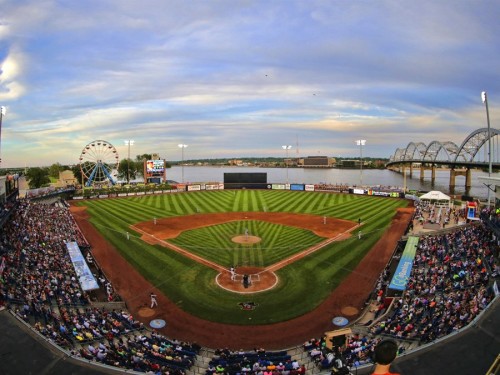
Modern Woodmen Park in Davenport is one of the most picturesque minor league baseball parks in the United States. Built in 1931, it is also steeped in history. Photo courtesy of Travel Iowa
By Don Doxsie
The idea surfaced as early as 1912. That’s when public officials in Davenport first mentioned the possibility of using the city’s riverfront levee for recreational use, possibly including a major athletic facility.
It continued to be a topic of conversation in the years that followed although it seldom went beyond the discussion stage.
Mike Sexton, the president of the Three-I League, spoke at the league’s post-season meeting in 1913 and said he felt Davenport simply had to build a baseball stadium in the downtown area, along the banks of the Mississippi River.
“Half the people of Davenport are baseball fans, and there is no reason why you should not have a municipal park out of a regular tax,’’ Sexton said. “You should have a park on the riverfront. It would mean a lot not only for the game here but for the town as well.’’
It didn’t actually happen until nearly two decades later when Municipal Stadium opened at the site of a former landfill at the foot of Gaines Street, just west of LeClaire Park. Through the years, Davenport’s ballpark has been renovated and rebuilt several times over. It has filled up with water more frequently than some bathtubs. It has been criticized, scrutinized, lionized and modernized. It’s still there all these years later and still routinely makes lists of the best minor league baseball parks in the entire country.
Now known as Modern Woodmen Park, it is among the most picturesque venues in all of minor league baseball. It sits within an easy toss of the biggest river on the continent and during lulls in the action, fans can lean back and watch barges and riverboats drifting past beyond the right-field fence. The majestic Centennial Bridge towers above behind the first-base line.
Due to the innovative marketing mind of current owner Dave Heller, a 105-foot Ferris Wheel now rises beyond the left-field wall. A handful of other amusement park rides have been added around the fringes of the ballpark to make it even more of an attraction for families.
But in the beginning, in 1931, there were no ziplines or bumper cars, just a shiny new concrete and steel ballpark to serve as the home of the Davenport Blue Sox.
It didn’t happen without some prodding. John O’Donnell, the youthful sports editor of the Davenport Democrat, began lobbying for the stadium to be built not long after he began working for the local paper in 1925. The Blue Sox and other local teams had played their games on a modest field at the Mississippi Valley Fairgrounds on the west side of town. O’Donnell spearheaded the movement to get the city something better.
He wrote about the need for “a good stadium or no stadium at all’’ and wrote that the Davenport Levee Improvement Commission “wanted a structure that would beautify the riverfront, not an eyesore.’’
Not surprisingly, within a year after he died in March of 1970, the stadium was renamed in his honor. It was John O’Donnell Stadium until the 2008 season, when the corporate naming rights were sold to Modern Woodmen of America, a fraternal financial services organization whose corporate offices are visible out across the river in Rock Island, Ill.
The decision to build the new park wasn’t made until September 1930, but the levee commission decided to fast-track the project. It was constructed during the winter months using all local workers, providing jobs in a community that was beginning to be impacted by the Great Depression. The project cost $185,000 — $20,000 of that was used to install lights, a new innovation in that era — but no taxpayer funds were used. It was completely paid for by revenue from new riverfront properties that the city leased to companies.
The original seating capacity was 5,500, including 4,000 in the grandstand and 1,500 in the bleachers.
When the stadium finally was set to open in late May 1931, O’Donnell wrote, “The sun will shine, the Mississippi will glisten and all will be well with the world.’’
TO READ MORE ABOUT THIS STORY AND OTHER FASCINATING STORIES ABOUT IOWA HISTORY, subscribe to Iowa History Journal. You can also purchase back issues at the store.
